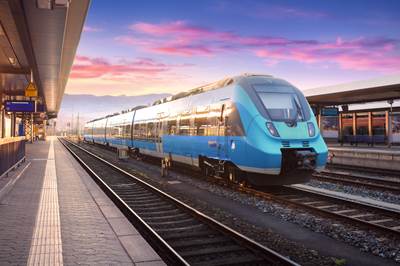Hexagon Purus reports significant customer, contract growth for 2020
Since its 2020 spin-off, the company has been awarded numerous contracts, indicating increased adoption of composite pressure vessels, fuel storage and electric drivetrain solutions.

Photo Credit: Hexagon Purus
E-mobility company Hexagon Purus (Ålesund, Norway) has detailed several significant accomplishments in 2020 per its annual report. Of notable importance, the company grew its customer base and mobility segment contracts — including Hino Trucks (heavy-duty trucks; Novi, Mich., U.S.), New Flyer (transit; Manitoba, Canada), Everfuel (distribution; Denmark), and Stadler (rail; Bussnang, Switzerland). This, in turn, laid the groundwork for entering China’s clean mobility market through a joint venture with CIMC Enric (China). The end of the year saw Hexagon Purus listed on Euronext Growth exchange (Oslo, Norway) and up to NOK 750 million (USD $86.7 million) gross proceeds raises in a private placement, with an expectation to grow revenue by at least 50% in 2021.
Becoming a spin-off company from Hexagon Composites ASA (Hexagon, Alesund, Norway) in late 2020, Hexagon Purus’ activities have been focused on obtaining sufficient capital to accelerate its developments and fund its future growth for high-pressure composite hydrogen storage cylinders, fuel storage and distribution systems and electric drivetrain solutions. The company has pursued these objectives via several awarded contracts.
For example, July 2020 saw the company awarded a USD $5.2 million contract for the design, development, qualification and production of high-performance Type IV composite pressure vessels to a new major aerospace customer for its launch vehicle. Other contracts include the company’s selection in August by a key Northeast Asian OEM for the serial supply of composite cylinders for its current zero-emission fuel cell electric (FEC) SUV, and a purchase order from Hino Trucks, a Toyota Motors company, to provide battery packs and drivetrain integration for three trucks as part of Hino’s “Project Z” BEV program. This led to an additional contract to supply hydrogen systems to Toyota Motor North America (TMNA) for its newest prototype hydrogen-powered, heavy-duty FEC powertrains. This was the third heavy-duty truck project in three years that Hexagon Purus collaborated on with Toyota.
During the same year, Hexagon Purus also signed a multiyear master frame agreement with Everfuel to deliver multiple units of newly designed 45-foot, hydrogen distribution systems with an estimated sales value of EUR €14 million. The systems will be used to transport hydrogen to refueling stations serving hydrogen FEC passenger car fleets (e.g., taxis), trucks and buses. At signing, Everfuel ordered its first six distribution units under the new frame agreement. The new system will have a nominal payload capacity of 958 kilograms of compressed hydrogen at 300 bar.
Similarly, Hexagon Purus signed a contract with a major U.S. hydrogen fuel supplier and refueling station operator to provide multiple X-Store all-composites, 20-foot transport modules for the distribution of high-pressure hydrogen gas with an estimated sales value of USD $4.8 million.
In accordance with its exponential growth, Hexagon Purus says it is entering 2021-2022 with several objectives. In addition to preparing its North American and European facilities for increased volume, the company hopes to diversify its customer base and ramp up its CIMC Enric joint venture in China, aiming at 100,000 cylinders per year, starting with high-pressure Type III cylinder production in 2021. The company also hopes to continue building its organizational capabilities and resources, and improve cost efficiency and manufacturing productivity with increased automation and optimized value streams.
View the full report here.
Related Content
NCC reaches milestone in composite cryogenic hydrogen program
The National Composites Centre is testing composite cryogenic storage tank demonstrators with increasing complexity, to support U.K. transition to the hydrogen economy.
Read MoreHexagon Purus opens new U.S. facility to manufacture composite hydrogen tanks
CW attends the opening of Westminster, Maryland, site and shares the company’s history, vision and leading role in H2 storage systems.
Read MorePolar Technology develops innovative solutions for hydrogen storage
Conformable “Hydrogen in a Box” prototype for compressed gas storage has been tested to 350 and 700 bar, liquid hydrogen storage is being evaluated.
Read MoreHow composites have become a necessity
Composites used to be one of many material options across industries and applications, but that's not the case anymore.
Read MoreRead Next
Hexagon Purus to supply composite pressure vessels for U.S. hydrogen-powered commuter train
The contract includes the development and approval of a developed cylinder storage system, with a hydrogen-powered train built and transferred to California by 2023.
Read MoreDeveloping bonded composite repair for ships, offshore units
Bureau Veritas and industry partners issue guidelines and pave the way for certification via StrengthBond Offshore project.
Read More“Structured air” TPS safeguards composite structures
Powered by an 85% air/15% pure polyimide aerogel, Blueshift’s novel material system protects structures during transient thermal events from -200°C to beyond 2400°C for rockets, battery boxes and more.
Read More
























